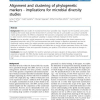Free Online Productivity Tools
i2Speak
i2Symbol
i2OCR
iTex2Img
iWeb2Print
iWeb2Shot
i2Type
iPdf2Split
iPdf2Merge
i2Bopomofo
i2Arabic
i2Style
i2Image
i2PDF
iLatex2Rtf
Sci2ools
BMCBI
2010
2010
Alignment and clustering of phylogenetic markers - implications for microbial diversity studies
Background: Molecular studies of microbial diversity have provided many insights into the bacterial communities inhabiting the human body and the environment. A common first step in such studies is a survey of conserved marker genes (primarily 16S rRNA) to characterize the taxonomic composition and diversity of these communities. To date, however, there exists significant variability in analysis methods employed in these studies. Results: Here we provide a critical assessment of current analysis methodologies that cluster sequences into operational taxonomic units (OTUs) and demonstrate that small changes in algorithm parameters can lead to significantly varying results. Our analysis provides strong evidence that the species-level diversity estimates produced using common OTU methodologies are inflated due to overly stringent parameter choices. We further describe an example of how semi-supervised clustering can produce OTUs that are more robust to changes in algorithm parameters. Con...
| Added | 08 Dec 2010 |
| Updated | 08 Dec 2010 |
| Type | Journal |
| Year | 2010 |
| Where | BMCBI |
| Authors | James Robert White, Saket Navlakha, Niranjan Nagarajan, Mohammadreza Ghodsi, Carl Kingsford, Mihai Pop |
Comments (0)

